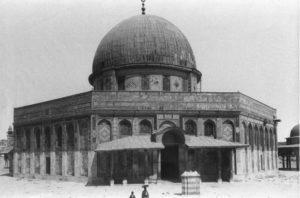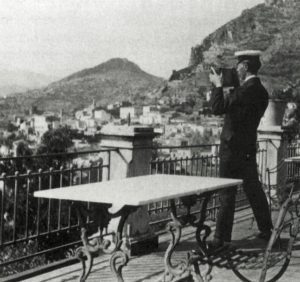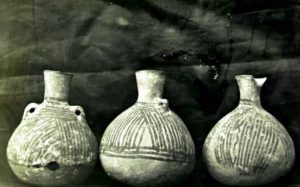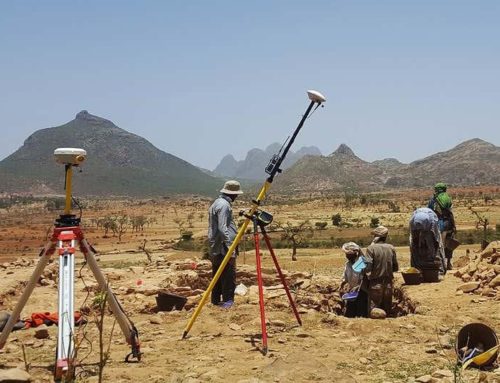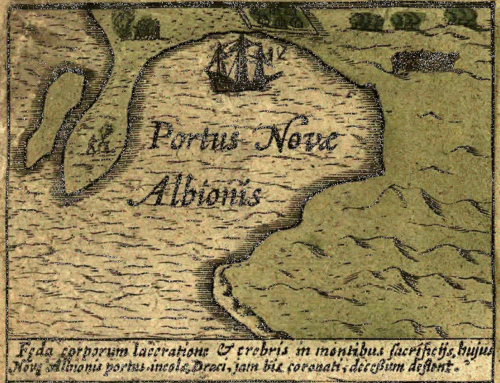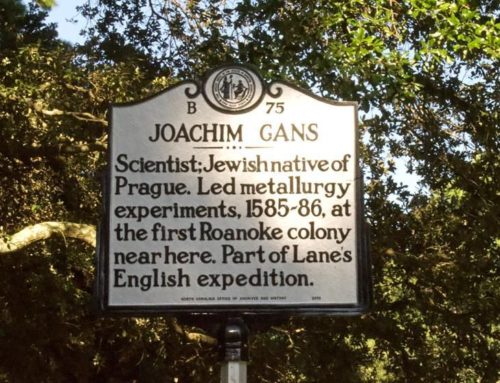A British aristocrat looking for the Ark of the Covenant launched history’s most peculiar archaeological dig—and set off a crisis in the Middle East
By Andrew Lawler, Published October 25, 2021
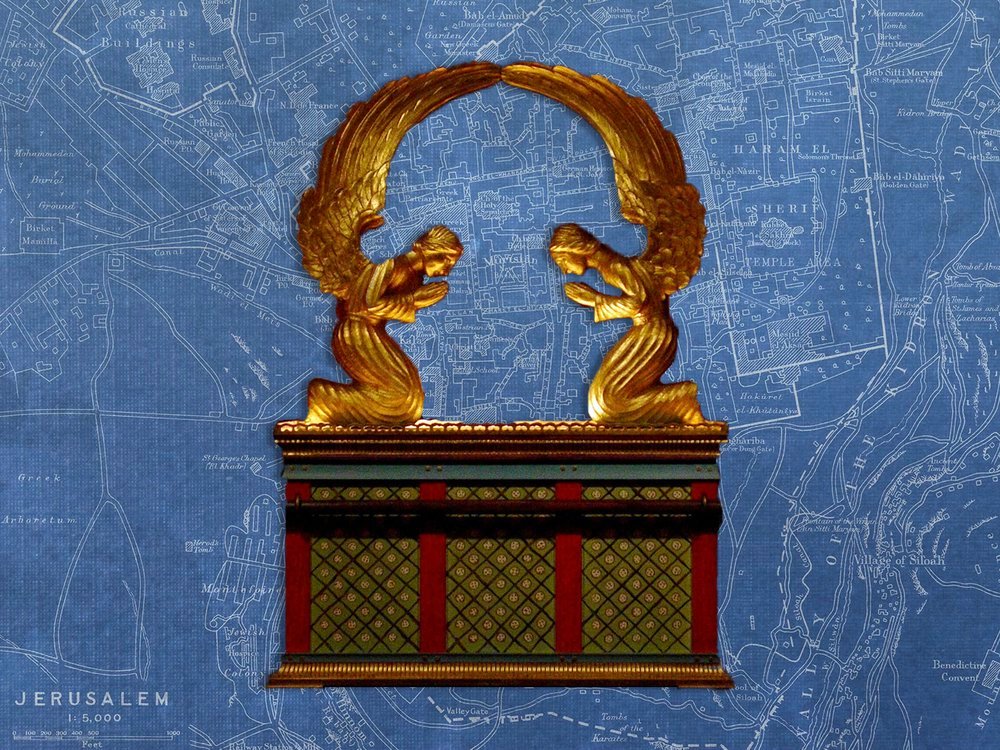
A new book by journalist Andrew Lawler chronicles an illicit 1909–1911 excavation in Israel’s Holy City. Pictured here: a replica of the Ark of Covenant in front of an early 20th-century map of Jerusalem Photo illustration by Meilan Solly / Photos: Public domain, Ben Schumin via Wikimedia Commons under CC BY-SA 2.5
In the annals of archaeology, it ranks as the most bizarre excavation team. Led by a handsome British aristocrat, its members included a Swiss psychic, a Finnish poet, an English cricket champion and a mustachioed Swede who once piloted a steamboat on the Congo River. None had any training in the field.
Nor was the object of their search ordinary. This motley assemblage arrived in Jerusalem in 1909, when the Holy City was still under the authority of the Ottoman Empire, ruled from Istanbul. They sought nothing less than the famed Ark of the Covenant, along with treasures gathered by King Solomon 3,000 years ago that, according to legend, were later hidden.
Long before Raiders of the Lost Ark was a box-office smash, this band of unlikely explorers launched a secret dig that blew up into an international scandal that shook the Middle East, with consequences still felt today.
It all began when an obscure Scandinavian scholar suggested that he had unraveled a secret biblical code that pinpointed the site of the buried sacred treasure. The surviving notes of Valter Juvelius are a mass of scribbled numbers, obscure phrases and references to scripture, so exactly which cipher he claimed to have decoded is unclear. But he was convinced the sacred objects rested in a Jerusalem tunnel. Juvelius traveled across Europe, fruitlessly seeking a patron until he secured an introduction to Captain Montagu Brownlow Parker, the 30-year-old brother of an English earl.
A Boer War veteran and feckless London socialite, Parker was intrigued. He agreed to serve as the expedition leader and set up a syndicate to sell 60,000 one-pound shares in the venture. His status, charm and dashing looks proved irresistible to an array of investors, from Chicago meatpacker J. Ogden Armour to the duchess of Marlborough. They ponied up the equivalent of $2.4 million today to cover expenses.
Parker’s winning argument was that this paltry sum would recover not only the world’s most famous sacred artifact, but also an enormous fortune. He estimated that the Ark, along with the many gold and silver platters and bowls and other precious objects mentioned in the biblical text, would net $200 million on the art market—some $5.7 billion today. Searching for the Ark was not simply a spiritual quest; it would be an immensely profitable one as well.
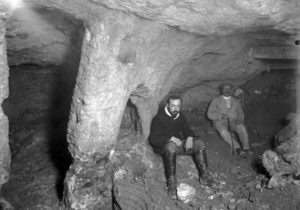
Valter Juvelius (left) and an unidentified member of the Parker mission Public domain via Wikimedia Commons
There is a hint that Parker’s interest in the treasure was neither pious nor greedy, but ultimately romantic. One American newspaper later claimed that he agreed to lead the venture in order to obtain the hand of a wealthy divorcée. “Well, bring back the Ark of the Covenant and I will talk to you again,” she is alleged to have said.
The Ark is described in the Book of Exodus as a rectangular wooden chest made of acacia wood, covered in gold leaf and topped with statues of two cherubim on its gold lid. Scripture maintains it was built to hold the two tablets inscribed with the Ten Commandments soon after the Israelites departed Egypt. “There, above the cover between the two cherubim that are over the Ark of the Covenant law, I will meet with you and give you all my commands for the Israelites,” God tells Moses, while providing detailed instructions on the design of the portable box that could be carried with two wooden staves.
Such shrines were common in the ancient Near East. A similarly sized wooden chest was discovered in King Tut’s tomb, while others in Egypt have been found topped with statues of deities and used as sarcophagi. Some were ceremonial boats carried by priests on poles. The cherubim from the Bible were likely derived from Babylonian tradition.
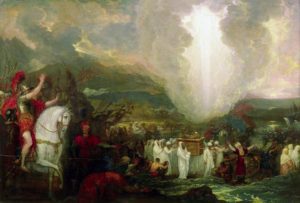
Benjamin West, Joshua Passing the River Jordan With the Ark of the Covenant, 1800 Public domain via Wikimedia Commons
What set the Ark apart from its Near Eastern cousins was the biblical claim that it served as a powerful spiritual weapon, capable of parting the Jordan River, bringing down the walls of Jericho and generally routing any enemy of the Israelites. King David was said to have brought it to Jerusalem; he danced ecstatically before the sacred object as it entered the city. Eventually, it came to rest on the city’s Temple Mount in Solomon’s temple, within the chamber known as the Holy of Holies—the central sanctuary accessible only to the high priest, and then only once a year. Its presence would have given the mountain town a new and powerful religious might, yet it is never again mentioned in the Bible.
In 586 B.C.E., the Babylonian army attacked Jerusalem and “carried to Babylon all the articles from the temple of God, both large and small, and the treasures of the Lord’s temple and the treasures of the king and his officials,” as reported in the biblical Book of Chronicles. It’s unclear whether the Ark itself was among these objects; the invaders were, in any case, the third army mentioned in the Bible that had looted the sanctuary. Whether taken, hidden or destroyed, the Ark’s fate has spawned innumerable legends, hundreds of books and one Steven Spielberg blockbuster.
Candidate locations for the lost Ark include an Ethiopian church, an Irish bog, a Vatican basement, an Egyptian temple, a Jordanian mountaintop and a Dead Sea cave. Some Jewish traditions insist that priests hid the Ark and other treasures under or near the Temple Mount, where they allegedly remained even after the Roman destruction of the last Jewish sanctuary in 70 C.E.
Nineteen centuries later, the golden Dome of the Rock and the sprawling al-Aqsa Mosque rose above the parks and fountains of Islam’s third holiest site. Excavating on what Muslims call the Noble Sanctuary was strictly forbidden by the Istanbul-based sultan, who was caretaker of Islam’s most sacred places. Juvelius, though, believed that “his rendering of the Hebrew text denoted that the Ark of the Covenant could be found by working up the hill through underground passages,” as one expedition member later wrote.
These passages lay under a rocky ridge extending south of the acropolis, which archaeologists had recently determined was the site of the ancient city conquered by King David sometime after 1000 B.C.E. Outside the Old City’s walls, this spur of land was largely pasture and at a safe distance from the Noble Sanctuary. It was just a matter of penetrating the ridge to find the tunnel that led uphill to Solomon’s treasure.
Parker traveled from London to Istanbul and secured an excavation permit in exchange for 500 British pounds—about $80,000 today—along with a secret deal to share half the loot with Ottoman officials. In the summer of 1909, the bulk of the team arrived at the Palestinian port city of Jaffa, though their disembarking was delayed by an outbreak of bubonic plague. Once in Jerusalem, the group rented a luxurious villa outfitted with Persian rugs and long-hosed hookahs, with one room dedicated to the valuable finds they were certain they would soon collect.
“They were certainly the oddest archaeologists to visit Jerusalem,” remarked Bertha Spafford Vester, an American missionary who grew up in the city. “We heard of gay dinners given by the Englishmen, once with the Turkish Pasha as guest, and of their using oranges for target practice.”
Vester’s amusement turned to anger when she learned that the team intended to dig on the historic slope south of the Noble Sanctuary. She was appalled by “their complete lack of archaeological knowledge.” This was no exaggeration; one of the expedition members insisted that the Ark must be found on Mount Ararat, apparently having confused Noah’s Ark with that of King David. Under pressure from local expats, Parker agreed to grant access to a French monk who was also an archaeologist to record their finds—though the object of their search was kept strictly confidential.
The dig itself was difficult to keep secret, since it was the largest in Jerusalem’s history to date. Nearly 200 workers burrowed four-and-half-feet-high passages beneath the ridge, with air supplied by mechanical pumps. “We lived underground nearly the whole time it was daylight,” the French monk later reported. “The work went on at nightfall without stopping, by the light of torches and to the sound of songs chanted by the workmen.” They encountered numerous ancient passages-—“dark mysterious tunnels which seemed to stretch endlessly into the very entrails of the rock.” But the monk said that the only artifacts they found were “some old Jewish flat lamps made of baked clay, some red pottery jars [and] a few metal sling balls.”
There was no sign of gold or silver, much less the Ark. Soon, the weather turned bitterly cold and damp; at one point, the workers went on strike. That fall, Parker and his team packed up and left until the following summer. When they returned, it was with the chief engineer of London’s revolutionary subway system, known as the “tube.” By then, Juvelius had fallen ill with malaria and grown disillusioned with the search. He sailed home as Ottoman officials monitoring the dig grew impatient with the delays. The diminished team worked through the next winter with no better luck.
By the spring of 1911, with only a few months left before the permit expired, Parker concocted a foolhardy and dangerous plan. He bribed the Muslim sheikh in charge of the Noble Sanctuary and had him send the guards to an Islamic festival taking place outside of town. For the first time since the Crusades, the revered site was vulnerable to foreign trespassers. For nine subsequent nights, Parker and his men shoveled away at various places on the platform, but to no avail.
Finally, with time running out before the festival ended, Parker made an even rasher decision. On the tenth night, he and a small team entered the shallow cave beneath the Dome of the Rock—known to Westerners as the Mosque of Omar—close to the very place where Mohammad was said to have ascended into heaven. The aristocrat was convinced that this was the obvious resting place of the Ark, since it was rumored to mark the spot of Solomon’s long-lost Holy of Holies. It was also a spot surpassed only by Mecca and Medina in sanctity among Muslims.
The particulars of what took place on the night of April 12, 1911, are fuzzy. Either a sleepless resident stumbled onto the workers as they hacked away at the rock or a caretaker not in on the secret heard the noise and raised the alarm. What is beyond dispute is that the Muslim residents of Jerusalem quickly filled the streets, infuriated at the news that their holy site was under Christian attack. Fearing for their lives, Parker and his friends fled, quickly jumping on the train to Jaffa. They coolly had tea in the harbor town before offering to fête Ottoman immigration officials on their yacht. Parker and his colleagues rowed to the boat to prepare for their guests—and then promptly sailed away.
Rumors swirled around the globe that the foreigners had made off with the staff of Moses, the tablets of the Ten Commandments or any number of possible other relics. “Gone with the Treasure that was Solomon’s” read the May 4 banner headline in the New York Times, over the subheading: “English Party Vanishes on Yacht after Digging under the Mosque of Omar.” Three days later, the same newspaper published a long feature titled “Have Englishmen found the Ark of the Covenant?” The Times reported: “It is believed that the explorers found Solomon’s crown, his sword and his ring, and an ancient manuscript of the Bible.”
Meanwhile, some 2,000 demonstrators took to the city’s streets demanding justice. “There was an awful row, which required both battalions of Turkish Infantry, quartered in Jerusalem, to quell,” one expedition member wrote. The Noble Sanctuary’s sheikh and the city’s governor were arrested, but that did little to tamp down the public fury. “Moslems in a Rage” in a “Recent Sensation from Jerusalem,” read the headline of Washington, D.C.’s Evening Star.
News reports in the European press even suggested that Parker’s debacle might lead to the overthrow of the government in Istanbul. On May 8, the Ottoman parliament met in a contentious special session. Arab lawmakers presented evidence that the Jerusalem pasha and local military commander had been bribed by Parker. “The government covers everything up,” concluded a scandalized representative from the Black Sea region. One government minister drew hoots when he insisted that their share of Parker’s treasure would have been enough to have pay off nearly the entire national debt. In the end, all senior officials were cleared of wrongdoing, though the governor of Jerusalem lost his job.
One American newspaper warned that the treasure hunt by the Christian adventurers “might have provoked a holy war throughout the world.” This was no exaggeration: The events in the Holy City drew condemnation from Islamic leaders around the globe, including in British India. A commission of Indian Muslims investigated the incident and eventually concluded that nothing had been looted. Officials in London breathed a sigh of relief.
Parker returned to Britain without having grasped the consequences of his actions. Nor did the British Foreign Office appear to rein in the rogue aristocrat. Astonishingly, he went back in September of that same year for a second try at the alleged treasure. Advised by Ottoman friends not to land where he had previously anchored at Jaffa, Parker boldly sailed instead to Istanbul. But war had broken out between the empire and Italy, and no bribe could win him a new permit; the war took precedence over digging for gold. Parker never returned to Jerusalem, and the incident of 1911, if remembered at all, was dismissed in the West as a minor comic opera.
Yet this improbable expedition did more than inspire others to seek the Ark. It quietly seeded an intense distrust for archaeology among Palestinian Muslims while laying the foundation for Palestinian nationalism. According to Brooklyn College historian Louis Fishman, the incident demonstrated to local Arabs that the Ottomans could not be trusted to protect the Noble Sanctuary; it was up to the Palestinians to ensure its sanctity. The Dome of the Rock and the sacred platform soon emerged as a central symbol of rising Palestinian nationalism. This put Jerusalem’s Muslims on a direct collision course with the rising tide of Jewish immigrants, who crowded along the nearby Wailing Wall to pray.
The British went on to occupy Jerusalem and administer Palestine in the wake of World War I, while Parker served in the British army in France and then stepped out of the spotlight. On the death of his brother in 1951, he became the Fifth Earl of Morley and resided at an elegant Georgian mansion outside of Plymouth. So far as is known, he never spoke or wrote about his Jerusalem misadventure again. Needless to say, he never won the hand of the socialite, instead dying a bachelor in 1962.
Adapted from Under Jerusalem: The Buried History of the World’s Most Contested City by Andrew Lawler, to be published by Doubleday on November 2, 2021. Copyright © 2021 by Andrew Lawler.
